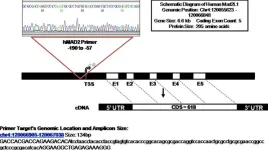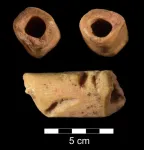(Press-News.org) The use of a digital remote monitoring technology in care homes has been found to reduce hospital A&E attendances by 11% and emergency admissions by 25% in a new study from the Health Data Research UK (HDR UK) Better Care programme, published today in Age and Ageing - the official journal of the British Geriatrics Society.
There are over 400,000 people living in care homes across the UK, many of whom will be living with complex medical needs that put them at greater risk of needing emergency healthcare, especially during the winter months.
Through the HDR UK Better Care programme, a collaboration between the universities of Sheffield, Durham, Lancaster and Newcastle, researchers set out to investigate the benefits of using a digital technology for remote health monitoring within care homes.
Health Call, an NHS-owned digital company, developed a smartphone app that care home staff can use to monitor and manage the long-term health of residents by recording daily observations. The information, held securely in the app, provides a way for doctors and other clinicians to review the resident and offer guidance for their care while the resident is in their home.
Researchers looked at the impact of using the Health Call app for 8,702 residents in 118 care homes across the North East of England between 2018 and 2021.
By linking routinely collected NHS secondary care data from County Durham and Darlington NHS Foundation Trust with data gathered within the care homes, the team show that using the Health Call app reduced the number of attendances to A&E by 11% and unplanned emergency admissions by 25%.
Alex Garner, a PhD student at the Centre for Health Informatics, Computing and Statistics at Lancaster University and first author on the study, said: “As the age of the UK population increases, finding solutions that improve care and quality of life for older people has become increasingly important.
"The findings of our study highlight the potential of data-driven solutions such as remote monitoring technology to improve care through reducing emergency attendances and admissions to hospital. Care home staff also reported that using the app boosted their confidence in being able to identify possible deterioration earlier and support better management of illnesses before hospitalisation is needed.
"Our hope is that these types of digital technology will play a vital role in improving communication between health service providers in the future, benefiting both patients and the NHS.”
In addition to assessing the impact on hospital attendance and admissions, the research team also performed a cost analysis. They found that use of Health Call within care homes led to a cost reduction for the NHS of £57 per resident in 2018, increasing to £113 in 2021.
Suzanne Mason, Professor of Emergency Medicine at the University of Sheffield and senior author on the study, said: “By having the capability to link data recorded by care home staff to data from NHS services, we were able to evaluate the impact of using a novel digital monitoring technology such as the HealthCall app. This study highlights the added value in capturing routine health data for research above and beyond that already being collected for the delivery of patient care.”
The app provides a structured method for seeking clinical advice for the management of care home residents who become unwell. Staff are trained to use the app to record the vital signs of the residents to allow calculation of the National Early Warning Score 2 (NEWS2) – used across the NHS to identify patients who may be at risk of deterioration. Carers can also upload free text describing a resident’s condition using a Situation, Background, Assessment, Recommendation (SBAR) approach, which is a structured form of communication used to enable information to be conveyed accurately.
Jo Knight, Professor in Applied Data Science at Lancaster Medical School and member of the Lancaster University Data Science Institute, said: “Given the opportunities that will result from the investment into NHS secure data environments, this research looking at how to use routinely collected data to improve health outcomes is timely and important.”
END
Notes to editor:
For further information, a copy of the paper or to request an interview, contact the HDR UK Communications team at media@hdruk.ac.uk or +44 7594 514007
Once published, the study will be available at https://academic.oup.com/ageing/article-lookup/doi/10.1093/ageing/afae004
An animation outlining the findings of the research is available. Please credit ‘Designed by Nifty Fox, 2023’: https://vimeo.com/834898374
Health Data Research UK is the national institute for health data that includes England, Wales, Scotland and Northern Ireland. Its mission is to unite the UK’s health data to enable discoveries that improve people’s lives. It is a charity funded by UK Research and Innovation, the Department of Health and Social Care in England and equivalents in Northern Ireland, Wales and Scotland, and leading medical research charities. www.hdruk.ac.uk END
Data-driven app results in 25% fewer emergency hospital admissions from care homes
2024-02-13
ELSE PRESS RELEASES FROM THIS DATE:
In rural states, gardening and foraging helped prevent hunger during COVID: Study
2024-02-13
New research on rural New Englanders shows that gardening, hunting, fishing and other HWFP activities are important tools for maintaining food security through extreme events, such as pandemics or climate change events.
University of Vermont and University of Maine researchers found that both food insecurity and home and wild food production (HWFP) – gardening, hunting, fishing, foraging, and having “backyard” poultry or livestock – increased significantly during the COVID-19 pandemic, and those who undertook HWFP activities exhibited improved food security 9-12 months later.
The paper, published in Scientific Reports, surveyed ...
New study finds roughly 1 in 10 pregnant people will develop long COVID
2024-02-13
UNDER EMBARGO UNTIL: Feb. 12, 2024 5:45 p.m. Eastern Standard Time
Media Contacts: Karen Addis, APR, karen@addispr.com, +1 (301) 787-2394; Kerri Wade, MPA, kwade@smfm.org, +1 ...
Differential expression of Mad2 gene in human esophageal cancer
2024-02-12
“[...] people of the northeastern region [of India] consume betel quid, consisting of raw areca nut [...]. People often swallow the entire betel-quid after chewing, which is believed to contribute to the development of oral, esophageal, and gastric cancers.”
BUFFALO, NY- February 12, 2024 – A new research paper was published in Oncotarget's Volume 15 on February 5, 2024, entitled, “Differential expression of Mad2 gene is consequential to the patterns of histone H3 post-translational modifications in its promoter region in human esophageal ...
RIT's Center for Detectors to work on two NASA projects
2024-02-12
Rochester Institute of Technology’s Center for Detectors has been chosen by NASA for two research programs: Early Stage Innovations (ESI) and Strategic Astrophysics Technology (SAT), with the hope of helping future spacecraft find new discoveries in the vast universe.
Under the leadership of Center for Detectors Director Don Figer, the team will be advancing and characterizing single-photon sensing complementary metal-oxide semiconductor (CMOS) image sensors to determine if they can survive the harsh radiation environments in NASA missions. The intent is to fly these types of detectors on future missions to find life on Jupiter’s ...
Archaeologists discover oldest known bead in the Americas
2024-02-12
University of Wyoming archaeology Professor Todd Surovell and his team of collaborators have discovered a tube-shaped bead made of bone that is about 12,940 years old.
The bead, found at the La Prele Mammoth site in Converse County, is the oldest known bead in the Americas.
Surovell’s research was published in the peer-reviewed journal Scientific Reports; the paper is titled “Use of hare bone for the manufacture of a Clovis bead.” Members of the research team included people from UW, the Office of the Wyoming State Archaeologist, the University of Manchester, Weber ...
Interferon-gamma drives brain pathology in a mouse model of multiple system atrophy
2024-02-12
BIRMINGHAM, Ala. – Multiple system atrophy is a rare and fatal neurodegenerative disease, where insoluble inclusions of the protein alpha-synuclein appear in oligodendrocyte cells of the brain. The resulting pathogenesis features neuroinflammation, demyelination and neurodegeneration. Oligodendrocytes produce myelin, an insulating sheath on the axons of nerves.
In 2020, Ashley Harms, Ph.D., and University of Alabama at Birmingham colleagues published an Acta Neuropathologica study that used a mouse model to show that the ...
Drought may drive deadly amphibian disease, researchers find
2024-02-12
UNIVERSITY PARK, Pa. — Pumpkin toadlets are in trouble. Progressively severe droughts are disrupting the microbiomes of the thumbnail-sized orange frogs, potentially leaving them vulnerable to a deadly fungal disease, according to a new study by an international research team. The finding suggests that abnormal rainfall patterns, which are expected to worsen due to climate change and deforestation, may upset mutually beneficial relationships between wildlife and microorganisms, leading to biodiversity decline.
The researchers, led by Penn State doctoral ...
New study finds commonly used antibiotic is a cost-saving treatment for reducing maternal sepsis, death or infection in developing countries
2024-02-12
UNDER EMBARGO UNTIL: Feb. 12, 2024, 4:30 PM EST
Media Contacts: Karen Addis, APR, karen@addispr.com, +1 (301) 787-2394; Kerri Wade, MPA, kwade@smfm.org, +1 (202) 236-1780
National ...
Reshaping our understanding of granular systems
2024-02-12
Your morning cereal, a jar of nuts, the sands of distant planets, and even the concrete in your city are all examples of granular systems surrounding us. And such systems are harboring secrets that could change the way we mix things up.
In a new paper published in the journal Proceedings of the National Academy of Sciences (PNAS), scientists at the University of Rochester, including Rachel Glade, an assistant professor of earth and environmental sciences and of mechanical engineering; Fernando David Cúñez, a former postdoctoral research associate ...
Can hydrogels help mend a broken heart?
2024-02-12
You can mend a broken heart this valentine’s day now that researchers invented a new hydrogel that can be used to heal damaged heart tissue and improve cancer treatments.
University of Waterloo chemical engineering researcher Dr. Elisabeth Prince teamed up with researchers from the University of Toronto and Duke University to design the synthetic material made using cellulose nanocrystals, which are derived from wood pulp. The material is engineered to replicate the fibrous nanostructures and properties of human tissues, thereby recreating its unique biomechanical properties.
"Cancer is a diverse disease and two patients with the same type of cancer will often respond ...




